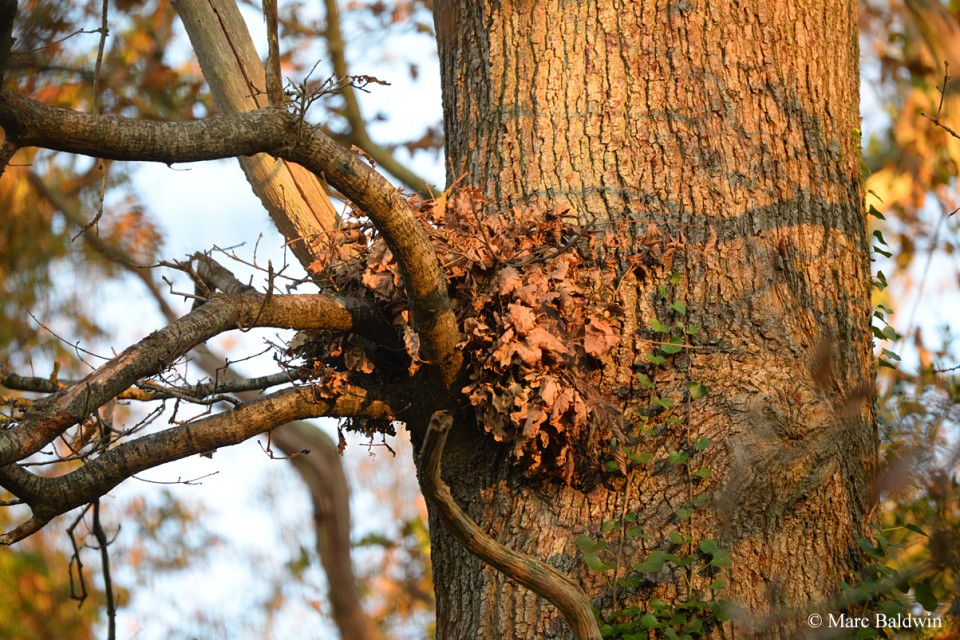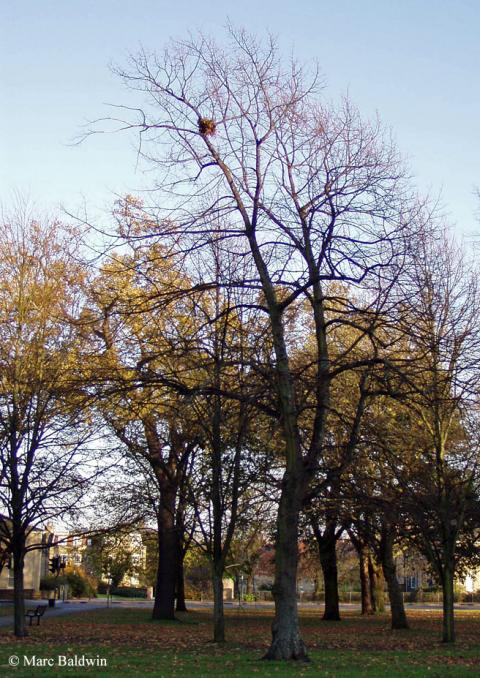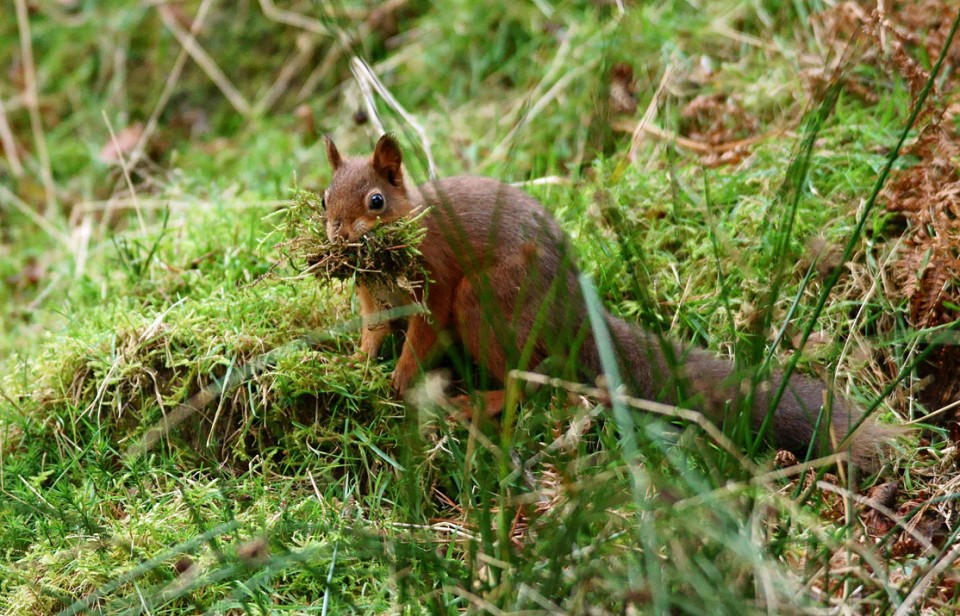Squirrel Nests & Refugia
In his 1974 opus, Mammals of Louisiana and its Adjacent Waters, the late eminent ornithologist George H. Lowery Jr. wrote that Grey squirrels create two types of ‘dens’. The first type is simply a den within a tree cavity (hollowed out, lined with moss and leaves and with an entrance hole of about 10cm/4in. diameter), while the second type consists of a ball or dome-shaped mass of leaves and twigs. According to Lowery, these dome-shaped dens can be located anywhere from ground level up to 12m (39ft) in a tree and are referred to as dreys.

Both Red and Grey squirrels construct dreys and the behaviour appears to be innate; hand-reared squirrels having no contact with wild animals construct their own nests from about six-weeks-old. We now know that there are actually three types of drey: summer, winter and breeding/natal. The former tends to be shallow platforms of twigs. Winter dreys are larger, typically about the size of a football (30cm / 12 in. diameter), and more robust, insulated nests composed of a frame of twigs interwoven with dry grass, moss and leaves and lined with mosses, lichen, soft bark, feathers and fur. Breeding dreys are intermediate between the two. It is not uncommon for a single squirrel to have several dreys. Nursing females will often move kittens to an alternative drey if she is disturbed and while radio-tracking Reds in a conifer plantation in northern England during his PhD, Peter Lurz found that each squirrel used between two and eight (average of four) different dreys, each situated in different locations throughout their home range.

In his fascinating 2003 book, Winter World, Bernd Heinrich comments how some Grey squirrel dreys to be appear haphazard piles of twigs, while others are very well-constructed. During his studies in North America, Heinrich found many dreys were simply "piles of junk" and suggests that these may have been 'fake' nests used to distract predators. Others were, however, very robustly engineered. When a heavy rainstorm blew a winter drey out of an oak tree onto his driveway, Heinrich dissected it and, in Winter World, described its construction:
"The outside layer of the 30-centimeter [12 in.] diameter globular nest was of red oak twigs with leaves still attached. The twigs had therefore been chewed off the tree during the summer. Inside this rough exterior I found layer upon layer (twenty-six in one spot where I counted) of single flattened dried green oak leaves. The multiple sheets of leaves served as watertight interlocking shingles, because the nest was dry inside. The leaf layers sheltered a 4-centimeter-thick [1.5 in.] layer of finely shredded inner bark from dead poplar and ash trees. This soft upholstering enclosed a round, cozy 9-centimeter-wide [3.5 in.] central cavity."
Dreys have several functions. They provide shelter from inclement weather, they provide some protection from predators, they provide a safe place to give birth and raise kittens and, perhaps most importantly, they provide insulation in very cold weather. Indeed, in his 1987 opus, The Natural history of Squirrels, veteran squirrel biologist John Gurnell comments that the ability of the Red squirrel to remain above ground during very cold winters, when species such as the pine squirrel (Tamiasciurus species) retreat underground, is a tribute to the insulation provided by their dreys.
In 2015, the BBC’s Winterwatch series mentioned that research in Finland has found the temperature inside a squirrel drey can be 20-30C (68-86F) warmer than the air temperature outside. These values come from a study by Erkki Pulliainen on Reds in northeastern Lapland over four winters between 1968 and 1973. Pulliainen put a thermometer inside the drey of a male squirrel and recorded the temperature every 30 seconds for six hours on a day in April 1971. The results show that at an air temperature of -5C (23F) the squirrel drey could be maintained at about 25C (77F), but this was after the squirrel had gone in and warmed it up with its body heat. When the squirrel was away from the drey the temperature typically dropped to 3 or 4C (38F), depending on how long the squirrel was away – at no point, however, did the nest drop below 0C (32F) while the squirrel was away, although it did reach 0.6C (33F) at one point. Once the squirrel re-entered the drey it took 10 to 30 minutes for the temperature to reach a stable 25C.

Despite being only a single dataset from a single nest, Pulliainen’s data do tie in well with those from other studies. In particular, a Russian study that measured the temperature of 65 dreys from January to March during the early 1930s found that, on average, the temperature inside the drey was 18.2C (64.8F) above the air temperature outside – measurements from 12 dreys from which the squirrel had recently departed found a temperature inside of between 10 and 19C (50-66F), while the air temperature outside ranged from -3 to -10C (26.6-14F). The temperature inside the Russian dreys never dropped below 0C.
Dreys tend to be built in stable locations, such as in the pit between the trunk and a sturdy branch or in the crown of a tree but, on a friend’s farm in Buckinghamshire, I have observed Grey squirrel dreys constructed at the end of branches that appear most precarious. There are also records of dreys built in some more unusual places, including in a gorse bush (Red), in the hollow of a fallen tree (Red), on the ground under snow-covered reeds (Red), in a great tit nest box (Red), in eaves/roofs of builds (Grey), under tree roots (Grey), in rabbit burrows (Grey) and in corn stacks (Grey).
In a paper to the Journal of Zoology in 1970, University of Edinburgh biologist Andy Tittensor described a Grey squirrel drey constructed on the ground among shrubs at Loch Lomond during May of 1969. During his study of 148 Red squirrel dreys in Edensmuir, Scotland, however, Tittensor found that all were in trees – 98% were constructed adjacent to the main trunk, either in a fork of the trunk, or in the angle of a large side branch or branches. Tittensor also observed that 64% of the dreys were built between 25-40m (82-130 ft.) above the ground. In The Eurasian Red Squirrel, Bosch and Lurz note that captive squirrels have built dreys in 12 hours, while wild individuals, which are more preoccupied finding food, typically take between two and five days to construct theirs.
Finally, drey building is typically carried out individually -- that is, each squirrel makes its own, despite multiple squirrels sharing the same nest on occasion -- but there are cases where two or more squirrels will work on a drey, which may or may not be shared.
The only example of cooperative nest building in squirrels that I’m familiar with in the literature is a short paper to The Canadian Field-Naturalist by John and Nancy Koprowski. One April afternoon during 1986, the Koprowskis observed a male and female Grey building a drey together in a honey locust tree in an urban area of Douglas County, Kansas. Together they collected an estimated 500 leaves for the nest and worked on the construction until it got dark. According to the Koprowski’s, the squirrels were “frequently in the nest simultaneously”, although they only watched the operation for three hours and don’t say if the squirrels spent the night in the drey together.
More recently, in early June 2020, Robert Stern got in touch to share his observation of three squirrels working on a drey outside his flat window in Maryland. Robert told me that he and his wife watched all three animals work on adding twigs to the outside and, later, one spending time adding leaves to the interior. At dusk, two of the squirrels left and only one spent the night in the nest. Further discussion with Robert and analysis of the videos he was able to provide suggests that this was a mother and two well-grown kittens working together on the nest that only the mother slept in that night. As mentioned above, nest building behaviour is innate and there’s no evidence that I’m aware of suggesting mothers actively teach their young how to build them, but it is possible they gain valuable practice working on their natal drey.